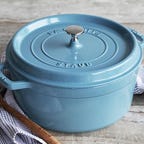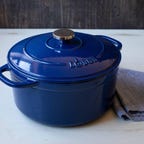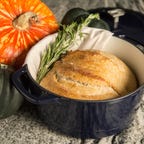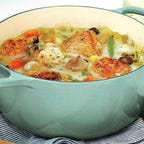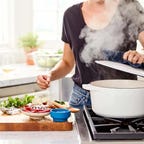What’s the best Dutch oven for 2024?
The Dutch oven may not seem like an important piece of cookware at first, especially if you’ve got several other pieces of pots and pans, but it shouldn’t be underestimated. Not only are Dutch ovens great for making stews or slow-cooking meats, but it’s really a piece of cookware that can be made to cook, well, absolutely anything. A nice fry-up? Stick everything in your Dutch oven. Forgot to clean your frying pan for scrambled eggs? Do it in the Dutch oven. Fancy a grilled sandwich? Dutch oven.
From Le Creuset to Lodge, we put a dozen Dutch ovens to the test, some including cast iron and enameled cast iron. Overall, we found the $199 Staub 4-quart cocotte to be the best Dutch oven you can buy, thanks to its decent price, solid build, and aesthetically pleasing design.
Furthermore, most Dutch ovens have a solid cast iron core, which is great for retaining heat, and a slick enameled coating that keeps food from sticking—perfect for dishes that require a consistent temperature over long periods. Thanks to a tight-fitting lid, the Dutch oven keeps moisture inside and further helps with the cooking process.
A quality Dutch oven can last decades or longer, and many folks who have one end up seeing it as an heirloom rather than just another piece of cookware. But, if you’re worried that your wallet will be severely hurting after purchasing one, don’t be! A good Dutch oven doesn’t need to cost hundreds of dollars. Going too cheap, though, may mean you end up with a pot that wears and chips faster than you’d like.
If you need more reasons to invest in this versatile pot, a Dutch oven looks great and does double duty as a serving vessel for dinner parties and holiday fetes. I lit the burner under nine Dutch ovens, from legacy producers to contemporary cookware makers.
These are the best Dutch ovens for every type of home chef.
Best Dutch ovens for 2024
If you’re willing to spend a bit of coin to secure one of the best Dutch ovens in the market, a regal Staub round cocotte won’t disappoint. It’s also about $150 cheaper than a Le Creuset oven of the same size but with no noticeable shortcomings in its build or performance.
Cocotte is the French term for a Dutch oven, and this Alsace-based legacy cookware brand certainly knows its way around a beautiful piece of cookware. Staub’s cocotte comes in several sizes and a litany of colors — 10 to be exact — all with a durable enamel finish and solid cast iron core.
Staub’s Dutch oven features a self-basting lid with spikes on the underside to encourage an even and continuous trickle of juices while cooking. This pretty pot is a perfect vessel for baking, frying, braising or browning your Dutch oven recipe favorites, like chili, casseroles, beef stew, pot roast, sourdough bread and more.
Enameled cast iron cookware is also extremely easy to clean and this luxury piece is no exception. Braises and roasts lift off the coated surface with the greatest of ease. I like the 4-quart size for singles and couples with no kids, but if you have more mouths to feed, consider upgrading to this 7-quart model.
You don’t necessarily have to spend an arm and a leg to get a great Dutch oven for your kitchen. The Lodge is widely heralded as one of the best for the price and we agree. Lodge Dutch ovens come in sizes ranging from 1.5 quarts to 7.5 quarts and three colors: red, white and blue.
The Lodge Dutch oven is made from classic cast iron with an enameled coating. It’s oven-safe up to 500 degrees Fahrenheit, and while you can technically put it in the dishwasher, it’s recommended to wash a Dutch oven by hand to avoid chipping the enamel finish or damaging the steel lid-lifting knob.
While the Lodge is a perfectly suitable choice, my favorite value Dutch oven is the Marquette Castings’ 4-quart Dutch oven for $80. It’s the perfect size if you’re regularly cooking for two or three but might be a bit small for groups larger than that. I banged and scraped it for months and found the enamel to be as durable as pricier models including Le Creuset and Staub. It’s also available in six attractive colors at this wallet-friendly price.
My only knock on this Dutch oven is that the square lid knob is sharp and less comfortable to grab than others.
If you’re familiar with Dutch ovens — or cookware at all, for that matter — you’ve probably heard of Le Creuset by now. The iconic French brand is considered by many to be the gold standard, and you can rest assured you’re getting a quality pot in Le Creuset’s signature Dutch oven but it’s worth noting, you’ll pay a premium for the name.
Le Creuset cast iron Dutch ovens are covered in vitrified porcelain making them easier to clean and resistant to stains, odors and acids. The non-reactive interior and cooking surface don’t need to be seasoned like a traditional cast iron Dutch oven, and you can use Le Creuset’s oven on essentially any cooking surface, including induction cooktops and even open fires. Additionally, Le Creuset’s signature Dutch ovens have large, easy-grip handles and a heat-resistant, stainless steel knob.
Every detail of Le Creuset’s pots has been considered and most folks who own one will tell you this pot is worth the investment. Plus, Le Creuset’s signature Dutch ovens come with a “limited” lifetime warranty, which means that if it’s defective, the company will replace it free of charge. The signature Dutch oven from Le Creuset starts at around $260 for a small 2-quart size and goes up from there. Expect to pay closer to $400 or a little more for a more practical 4- or 5-quart pot.
Direct-to-consumer cookware companies are popping up left and right, and Milo is an up-and-coming brand that sells quality Dutch ovens that look great at approachable prices. The Milo Dutch oven rivals models from a few of the more established cookware brands, with cast iron construction and durable enamel coating. The Milo also has an undeniable modern charm underscored by the black-and-white paint jobs.
The Milo Dutch has a 5.5-quart capacity and is oven-safe up to 500 degrees Fahrenheit. It can even go in the dishwasher without damaging the enamel, but I had no trouble hand-washing this pot. Milo offers a lifetime guarantee on its products, but I wouldn’t worry about it breaking down. In the several months I worked with the Dutch oven it didn’t show any signs of wear, and the build seems very sound.
It clocks in at a very reasonable $145 (currently at a 20% discount) and would make an excellent addition to a kitchen with a sleek, modern aesthetic.
This Dutch oven from direct-to-consumer kitchen brand Misen is different from others for a few reasons: It comes in a large 7-quart size, which should have plenty of cooking capacity for even the largest families. This is a heavy piece of cookware, clocking in at around 16 pounds with the lid.)
You can also opt for either a standard top with a steel knob or a grill lid that doubles as a cast iron grill pan. The grill top comes with a separate silicone lid to use as you would a normal pot topper just in case you want to use the grill pan and covered Dutch oven at the same time.
This large pot comes in five lovely shades. It’s protected by a quality enamel coating that showed no signs of wear or chipping in the several months I used it.
Many of today’s best Dutch ovens feature a porcelain-enameled finish that makes them nonreactive, easy to clean and impervious to stains and odors. If you like the taste imparted by nonenameled cast iron, you may want to consider the Lodge preseasoned bare cast iron Dutch oven.
This product doesn’t have an enamel exterior. Instead, it’s been preseasoned with vegetable oil. It has a 7-quart capacity that reviewers say is perfect for things like bread and soups, as well as many other dishes. Without enamel, it needs to be taken care of properly — that means careful washing and re-seasoning as needed — but the sturdy construction will last for decades.
If you’re the type of kitchen warrior who covets the cool piece of cookware that nobody’s heard of yet, then I would direct you to the elegant Vermicular cast iron oven pot.
This Japanese-made Dutch oven comes in multiple sizes and four hues — all of which are stunning so good luck deciding. I love the double-grip handles that make snatching it off the stove a breeze, and the pot has a very sturdy build and a sleek and minimalist design. One thing to note is that the bottom of the pot’s inside has grill ridges instead of a flat surface. This will help keep charred and burnt bits from sticking but it also sears a bit differently from a flat surface.
The Vermicular oven pot is available in four sizes from 1 quart up to 5.5. There is also a shallow version of the pot which would lend itself well to dishes like paella and egg frittata.
If you plan to use your Dutch oven for Thanksgiving and other fall holidays, you might consider this festive design. This adorable pumpkin-shaped pot has a 3.5-quart capacity and comes with all the features you’d expect from the luxury French cookware maker. It has a smooth enamel coating on the bottom, a tight-fitting lid and superior heat retention. Like many of the others, it’s oven-safe up to 500 degrees. A splurge, to be certain, but it’s the perfect centerpiece for your autumn table.
I’ll level with you, there are not a lot of scientific tests you can run on a Dutch oven, but they do vary quite a bit in terms of overall quality, durability, aesthetics and design. What it really comes down to is finding a pot that works for you in terms of size, shape, material and cost.
You’ll find Dutch ovens in just about any color.
Instead of running tests as we would for blenders and toasters, I hauled in more than 10 Dutch ovens and used them over a few months to cook various recipes. The goal was to ensure each pot was constructed with quality materials and designed for ease of use in the kitchen. I noted if any single Dutch oven showed sudden signs of wear: paint chipping or loose knobs, for example. I also looked to see if they had design glitches like ill-fitting lids, awkward handles or uneven bottoms.
I also weighed aesthetics when considering and ultimately recommending these Dutch ovens since they make excellent serving vessels once the recipe is finished. Don’t forget, you’ll likely have yours hanging around for many years to come.
Read more: Best Instant Pots
When shopping for the perfect Dutch oven, you’ll want to consider the size of the pot. That’s probably the most important decision you’ll make, so give it some real thought. The most popular interior sizes are between 4 and 6 quarts, but you can find products as small as 2 quarts or as large as 10 or more. If you make large holiday meals for your extended family, a bigger Dutch oven might serve you well. Larger pots will be heavy (especially when full of food). I think a 4-quart Dutch oven is best for a single person or couple, but I’d probably bump up to a 6-quart if I had a few kids or more mouths to feed on the regular. Most are cast iron so they’re not particularly light, so don’t overshoot the size just for the heck of it.
Dutch oven is a term often used interchangeably with French oven, oven pot or cocotte. These sturdy cooking pots typically feature thick walls and a tight-fitting lid (unlike casserole dishes) with a single handle, loop handles or a knob. Most are made from bare or enameled cast iron, which provides exceptional heat retention, although you can also find stainless steel Dutch ovens. This popular piece of cookware can be used on a stovetop, but most are tough enough to use in the oven, even on high heat.
You should never use metal spoons or spatulas with an enamel-coated Dutch oven. While enamel is more durable than Teflon, metal utensils will still scratch the surface and compromise the pot’s nonstick properties.
Dutch ovens come as small as 1 quart and as large as 8, but between 4 and 6 quarts are the sizes you’ll find most and are the most popular. Anything below 4 or above 6 quarts is considered a specialty size.
If you do a lot of stovetop cooking or frying, sauteing and browning, stick with a round model, as it will fit on the burner better. Some round models are called “double Dutch ovens,” where the lid is deep enough to use as a skillet. An oval Dutch will better fit long cuts of meat like tenderloins, rib roasts and large poultry, so if you plan to cook those frequently versus stews and shanks, consider an oblong shape.
 meganwoolsey Home
meganwoolsey Home



